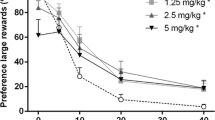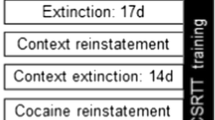Abstract
Rationale
Stop signal reaction time procedures are used to investigate behavioral and neurobiological processes that contribute to behavioral inhibition and to evaluate potential therapeutics for disorders characterized by disinhibition and impulsivity. The current study examined effects of amphetamine, methylphenidate, atomoxetine, and morphine in rats responding under an adjusting stop signal reaction time task that measures behavioral inhibition, as well as motor impulsivity.
Methods
Rats (n = 8) completed a two-response sequence to earn food. During most trials, responses following presentation of a visual stimulus (go signal) delivered food. Occasionally, a tone (stop signal) was presented signifying that food would be presented only if the second response was withheld. Responding after the stop signal measured inhibition and responding prior to the start of the trial (premature) measured motor impulsivity. Delay to presentation of the stop signal was adjusted for individual subjects based on performance.
Results
Amphetamine and methylphenidate increased responding after presentation of the stop signal and markedly increased premature responding. Atomoxetine modestly improved accuracy on stop trials and decreased premature responding. Morphine did not alter stop trial accuracy or premature responding up to doses that decreased the number of trials initiated.
Conclusions
These data demonstrate the sensitivity of an adjusting stop signal reaction time task to a range of drug effects and shows that some drugs that enhance dopaminergic transmission, such as amphetamine, can differentially alter various types of impulsive behavior.







Similar content being viewed by others
References
Bari A, Eagle DM, Mar AC, Robinson ES, Robbins TW (2009) Dissociable effects of noradrenaline, dopamine, and serotonin uptake blockade on stop task performance in rats. Psychopharmacology 205:273–283. https://doi.org/10.1007/s00213-009-1537-0
Blokland A, Sik A, Lieben C (2005) Evaluation of DOI, 8-OH-DPAT, eticlopride and amphetamine on impulsive responding in a reaction time task in rats. Behav Pharmacol 16:93–100
Boonstra AM, Kooij JJ, Oosterlaan J, Sergeant JA, Buitelaar JK (2005) Does methylphenidate improve inhibition and other cognitive abilities in adults with childhood-onset ADHD? J Clin Exp Neuropsychol 27:278–298. https://doi.org/10.1080/13803390490515757
Boyette-Davis JA, Thompson CD, Fuchs PN (2008) Alterations in attentional mechanisms in response to acute inflammatory pain and morphine administration. Neuroscience 151:558–563. https://doi.org/10.1016/j.neuroscience.2007.10.032
Broos N, Schmaal L, Wiskerke J, Kostelijk L, Lam T, Stoop N, Weierink L, Ham J, de Geus EJ, Schoffelmeer AN, van den Brink W, Veltman DJ, de Vries TJ, Pattij T, Goudriaan AE (2012) The relationship between impulsive choice and impulsive action: a cross-species translational study. PLoS One 7:e36781. https://doi.org/10.1371/journal.pone.0036781
Carli M, Robbins TW, Evenden JL, Everitt BJ (1983) Effects of lesions to ascending noradrenergic neurons on performance of a 5-choice serial reaction time task in rats: implications for theories of dorsal noradrenergic bundle function based on selective attention and arousal. Behav Brain Res 9:361–380. https://doi.org/10.1016/0166-4328(83)90138-9
Dalley JW, Robbins TW (2017) Fractionating impulsivity: neuropsychiatric implications. Nat Rev Neurosci 18:158–171. https://doi.org/10.1038/nrn.2017.8
de Wit H, Crean J, Richards JB (2000) Effects of d-amphetamine and ethanol on a measure of behavioral inhibition in humans. Behav Neurosci 114:830–837. https://doi.org/10.1037/0735-7044.114.4.830
de Wit H, Enggasser JL, Richards JB (2002) Acute administration of d-amphetamine decreases impulsivity in healthy volunteers. Neuropsychopharmacology 27:813–825. https://doi.org/10.1016/S0893-133X(02)00343-3
Dunnett C (1955) A multiple comparison procedure for comparing several treatments with a control. J Am Stat Assoc 50:1096–1121
Eagle DM, Robbins TW (2003) Inhibitory control in rats performing a stop-signal reaction-time task: effects of lesions of the medial striatum and d-amphetamine. Behav Neurosci 117:1302–1317. https://doi.org/10.1037/0735-7044.117.6.1302
Eagle DM, Tufft MR, Goodchild HL, Robbins TW (2007) Differential effects of modafinil and methylphenidate on stop-signal reaction time task performance in the rat, and interactions with the dopamine receptor antagonist cis-flupenthixol. Psychopharmacology 192:193–206. https://doi.org/10.1007/s00213-007-0701-7
Eagle DM, Bari A, Robbins TW (2008) The neuropsychopharmacology of action inhibition: cross-species translation of the stop-signal and go/no-go tasks. Psychopharmacology 199:439–456. https://doi.org/10.1007/s00213-008-1127-6
Eagle DM, Lehmann O, Theobald DE, Pena Y, Zakaria R, Ghosh R, Dalley JW, Robbins TW (2009) Serotonin depletion impairs waiting but not stop-signal reaction time in rats: implications for theories of the role of 5-HT in behavioral inhibition. Neuropsychopharmacology 34:1311–1321. https://doi.org/10.1038/npp.2008.202
Evenden JL (1999) Varieties of impulsivity. Psychopharmacology 146:348–361. https://doi.org/10.1007/PL00005481
Feldman HM, Reiff MI (2014) Attention deficit–hyperactivity disorder in children and adolescents. N Engl J Med 370:838–846. https://doi.org/10.1056/NEJMcp1307215
Feola TW, de Wit H, Richards JB (2000) Effects of d-amphetamine and ethanol on a measure of behavioral inhibition in rats. Behav Neurosci 114:838–848. https://doi.org/10.1037/0735-7044.114.4.838
Fineberg NA, Potenza MN, Chamberlain SR, Berlin HA, Menzies L, Bechara A, Sahakian BJ, Robbins TW, Bullmore ET, Hollander E (2010) Probing compulsive and impulsive behaviors, from animal models to endophenotypes: a narrative review. Neuropsychopharmacology 35:591–604. https://doi.org/10.1038/npp.2009.185
Hamidovic A, Dlugos A, Skol A, Palmer AA, de Wit H (2009) Evaluation of genetic variability in the dopamine receptor D2 in relation to behavioral inhibition and impulsivity/sensation seeking: an exploratory study with d-amphetamine in healthy participants. Exp Clin Psychopharmacol 17:374–383. https://doi.org/10.1037/a0017840
Logan GD (1994) On the ability to inhibit thought and action: a users’ guide to the stop signal paradigm. In: Dagenbach D, Carr TH (eds) Inhibitory processes in attention, memory, and language. Academic Press, San Diego, pp 189–239
Logan GD, Schachar RJ, Tannock R (1997) Impulsivity and inhibitory control. Psychol Sci 8:60–64. https://doi.org/10.1111/j.1467-9280.1997.tb00545.x
Madden GJ, Bickel WK (2010) Impulsivity: the behavioral and neurological science of discounting. American Psychological Association, Washington DC
Maguire DR, Henson C, France CP (2014) Effects of amphetamine on delay discounting in rats depend upon the manner in which delay is varied. Neuropharmacology 87:173–179. https://doi.org/10.1016/j.neuropharm.2014.04.012
Maguire DR, Henson C, France CP (2016) Daily morphine administration increases impulsivity in rats responding under a 5-choice serial reaction time task. Brit J Pharm 173:1350–1362. https://doi.org/10.1111/bph.13434
Maguire DR, Mendiondo C, France CP (2018) Effects of daily morphine treatment on impulsivity in rats responding under an adjusting stop-signal reaction time task. Behav Pharmacol [Epub ahead of print] 29:676–687. https://doi.org/10.1097/FBP.0000000000000398
Mahoney MK, Silveira MM, Olmstead MC (2013) Increased impulsive action in rats: effects of morphine in a short and long fixed-delay response inhibition task. Psychopharmacology 230:569–577. https://doi.org/10.1007/s00213-013-3190-x
Moeller FG, Barratt ES, Dougherty DM, Schmitz JM, Swann AC (2001) Psychiatric aspects of impulsivity. Am J Psychiatry 158:1783–1793. https://doi.org/10.1176/appi.ajp.158.11.1783
Murphy ER, Robinson ES, Theobald DE, Dalley JW, Robbins TW (2008) Contrasting effects of selective lesions of nucleus accumbens core or shell on inhibitory control and amphetamine-induced impulsive behaviour. Eur J Neurosci 28:353–363. https://doi.org/10.1111/j.1460-9568.2008.06309.x
Pattij T, Janssen MC, Vanderschuren LJ, Schoffelmeer AN, van Gaalen MM (2007) Involvement of dopamine D1 and D2 receptors in the nucleus accumbens core and shell in inhibitory response control. Psychopharmacology 191:587–598. https://doi.org/10.1007/s00213-006-0533-x
Pattij T, Schetters D, Janssen MCW, Wiskerke J, Schoffelmeer ANM (2009) Acute effects of morphine on distinct forms of impulsive behavior in rats. Psychopharmacology 205:489–502. https://doi.org/10.1007/s00213-009-1558-8
Robbins TW (2002) The 5-choice serial reaction time task: behavioural pharmacology and functional neurochemistry. Psychopharmacology 163:362–380. https://doi.org/10.1007/s00213-002-1154-7
Robinson ES, Eagle DM, Mar AC, Bari A, Banerjee G, Jiang X, Dalley JW, Robbins TW (2008) Similar effects of the selective noradrenaline reuptake inhibitor atomoxetine on three distinct forms of impulsivity in the rat. Neuropsychopharmacology 33:1028–1037. https://doi.org/10.1038/sj.npp.1301487
Safer DJ (2016) Recent trends in stimulant usage. J Atten Disord 20:471–477. https://doi.org/10.1177/1087054715605915
Sun H, Cocker PJ, Zeeb FD, Winstanley CA (2012) Chronic atomoxetine treatment during adolescence decreases impulsive choice, but not impulsive action, in adult rats and alters markers of synaptic plasticity in the orbitofrontal cortex. Psychopharmacology 219:285–301. https://doi.org/10.1007/s00213-011-2419-9
Tanno T, Maguire DR, Henson C, France CP (2014) Effects of amphetamine and methylphenidate on delay discounting in rats: interactions with order of delay presentation. Psychopharmacology (Berlin) 231:85–95. https://doi.org/10.1007/s00213-013-3209-3
van Gaalen MM, Brueggeman RJ, Bronius PF, Schoffelmeer AN, Vanderschuren LJ (2006) Behavioral disinhibition requires dopamine receptor activation. Psychopharmacology 187:73–85. https://doi.org/10.1007/s00213-006-0396-1
Winstanley CA (2011) The utility of rat models of impulsivity in developing pharmacotherapies for impulse control disorders. Br J Pharmacol 164:1301–1321. https://doi.org/10.1111/j.1476-5381.2011.01323.x
Wiskerke J, Schetters D, van Es IE, van Mourik Y, den Hollander BR, Schoffelmeer ANM, Pattij T (2011) μ-Opioid receptors in the nucleus accumbens shell region mediate the effects of amphetamine on inhibitory control but not impulsive choice. J Neurosci 31:262–272. https://doi.org/10.1523/jneurosci.4794-10.2011
Acknowledgements
The authors thank Caitie Labay for excellent technical assistance (Summer Undergraduate Research Fellow Award from the American Society for Pharmacology and Experimental Therapeutics).
Funding
The Welch Foundation (AQ-0039) supported this study, in part.
Author information
Authors and Affiliations
Corresponding author
Ethics declarations
Conflict of interest
The authors declare that they have no conflict of interest.
Additional information
Publisher’s note
Springer Nature remains neutral with regard to jurisdictional claims in published maps and institutional affiliations.
Rights and permissions
About this article
Cite this article
Maguire, D.R., France, C.P. Effects of amphetamine, methylphenidate, atomoxetine, and morphine in rats responding under an adjusting stop signal reaction time task. Psychopharmacology 236, 1959–1972 (2019). https://doi.org/10.1007/s00213-019-5183-x
Received:
Accepted:
Published:
Issue Date:
DOI: https://doi.org/10.1007/s00213-019-5183-x




